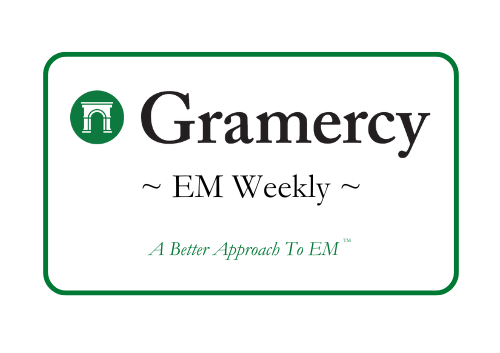Contents
Market Overview
Macro Update
This week a wealth of macro data provided a deeper view into the global economy, while the Trump Administration turned tariff threats into reality. On Wednesday, the U.S. announced a 25% levy on imports of all fully assembled vehicles, effective April 3rd. This came as the market is anxiously awaiting reciprocal tariff announcements next Wednesday, April 2nd.
Financial markets showed a modest rebound at the start of the week but are ending down on the back of unsettling data releases and continued tariff-related uncertainty. The S&P 500, Nasdaq and Dow are ending the week down 1%, 1.7% and 5.3%, respectively. In contrast, gold extended its rally, rising 2.0% to near $3,100, while the 10-year U.S. Treasury yield is ending the week flat at 4.3%. The U.S. Dollar Index (DXY) remained largely unchanged at 104, while the EUR/USD exchange rate settled at around 1.08.
Oil prices continued to recover this week as President Donald Trump announced a 25% tariff on countries buying oil and/or gas from Venezuela and as the U.S. signalled a greater willingness to expand sanctions against Iranian oil by sanctioning a Chinese refiner for taking Iranian crude. Brent was ending the week near $74 per barrel and WTI was approaching $70.
In the U.S., macroeconomic indicators continued to hint at stagflationary pressures – that is, slowing growth and higher inflation. The Conference Board’s survey of consumer confidence for March fell to its lowest level since July 2022, registering 92.9, below the consensus forecast of 94.0 and well behind February’s revised reading of 100.1. While durable goods orders rose 0.9% in February, this was a deceleration from January’s 3.3% increase, with business equipment orders declining, a signal that uncertainty around tariffs and tax policy is weighing on corporate investment. The University of Michigan’s final sentiment survey for March confirmed rising consumer anxiety: The headline index dropped to 57.0 from February’s 64.7, reflecting deteriorating optimism. Moreover, the median 12-month inflation expectation ticked up to 5.0%, underscoring concerns about persistently elevated prices.
On a more positive note, the preliminary U.S. Composite PMI for March rebounded to 53.5, surpassing both February’s 51.6 and consensus expectations of 50.9. Additionally, annualized quarter-over-quarter GDP growth came in at 2.4%, exceeding the expected 2.3%, and signalling that the U.S. economy retains solid momentum despite ongoing policy headwinds.
The Fed’s preferred inflation metric, known as the PCE price index, picked up more than expected in February in both monthly and annual terms, coming in at 0.4% (vs 0.3%) and 2.8% (vs 2.7%), respectively. The hotter-than-expected PCE data come amid increasing concerns by Fed policymakers that tariffs could translate into more persistent inflationary pressures.
In the UK, the Office for Budget Responsibility sharply downgraded its 2025 GDP growth forecast to 1.0% year-over-year, down from 2.0%. While medium-term growth prospects saw a slight improvement, the cumulative growth outlook through 2029 was revised lower, reflecting the growing risks posed by global uncertainty. As a result of these downgraded projections, the UK’s budget deficit has widened, compelling the government to implement spending cuts to address the more challenging fiscal landscape.
On a more positive note, UK inflation fell to 2.8% in February, outperforming expectations of 3.0%. Its preliminary Composite PMI for March also exceeded consensus at 52.0, compared to the expected 50.5. Retail sales showed surprising strength in February, further supporting the notion of a resilient economy.
In the eurozone, preliminary Composite PMI for March increased to 50.4, from 50.2 in February, but fell short of consensus forecast of 50.7. Preliminary March inflation figures in France and Spain were lower than expected, supporting calls for more dovish monetary policy by the ECB.
In emerging markets, Brazil’s Central Bank emphasized that its hawkish monetary policy stance would help bring inflation down to its 3% target over the medium term. It also reduced its 2025 GDP growth forecast to 1.9% year-over-year, down from 2.1%. Mexico, meanwhile, continued its easing cycle with a 50bps rate cut to 9.0%, in line with expectations. The Czech and Hungarian Central Banks held rates steady, citing the growing uncertainty surrounding the global trade conflict.
On the geopolitical front, the U.S. facilitated talks between Ukrainian and Russian delegations in Saudi Arabia, leading to a ceasefire agreement in the Black Sea.
EM Credit Update
EM fixed income markets were down on the week, with EM hard currency sovereign and corporate returns of -0.64% and -0.23%, respectively. Sovereign spreads widened by 1 bp at the index level, while corporate spreads tightened by 2 bps. Amid USD and UST yield stability, EM local currency sovereign bonds were also relatively unchanged, losing only 0.05%.
In the hard currency sovereign space, Senegal and Ethiopia were the main underperformers this week. In Senegal, the IMF estimated the fiscal deficit at close to 12% of GDP and public debt at ~106% of GDP following their staff visit to the country. In Ethiopia, political tensions appeared to be on the rise in the restive Tigray region, the epicenter of the recent civil war.
Indonesia, usually a stable, uneventful credit, also underperformed as investors weighed a few recent developments, including a rare fiscal deficit to start the year, contingent liability and governance risks from its sovereign wealth fund, Danantara, as well as an amendment allowing the military to take a greater role in government.
The Venezuelan bond complex continued to outperform as investors rekindled hopes for a pragmatic relationship between the administrations of President Trump and Venezuela leader Nicholas Maduro.
After a few slower weeks in primary market sovereign activity, this week saw new deals by Ivory Coast, Montenegro, Morrocco and Romania. Corporate activity remained robust with 23 deals coming to the market across EM regions.
The Week Ahead
On Wednesday, April 2nd – dubbed by President Trump as “Liberation Day in America” – reciprocal tariffs targeting imports from major trading partners are set to take effect. Canada plans to impose retaliatory tariffs on more than $125 billion of U.S. products and China’s factory activity report will show whether the economy is resilient amid higher U.S. tariffs and weak domestic demand.
ECB President Christine Lagarde and Chief Economist Philip Lane will be among the speakers at an ECB conference in Frankfurt. Later in the week, Fed Chair Jerome Powell will speak at a conference in Virginia.
In the geopolitical arena, EU defense ministers will hold an informal meeting in Warsaw. In Brussels, NATO foreign ministers will gather for the first time since President Trump’s inauguration, at arguably the most precarious moment in the alliance’s history. The week will wrap up with the U.S. jobs report for March. Forecasts reflect early signs of a cooling labor market as initial estimates project 135,000 jobs were added, down from 151,000 in February.
Fixed Income
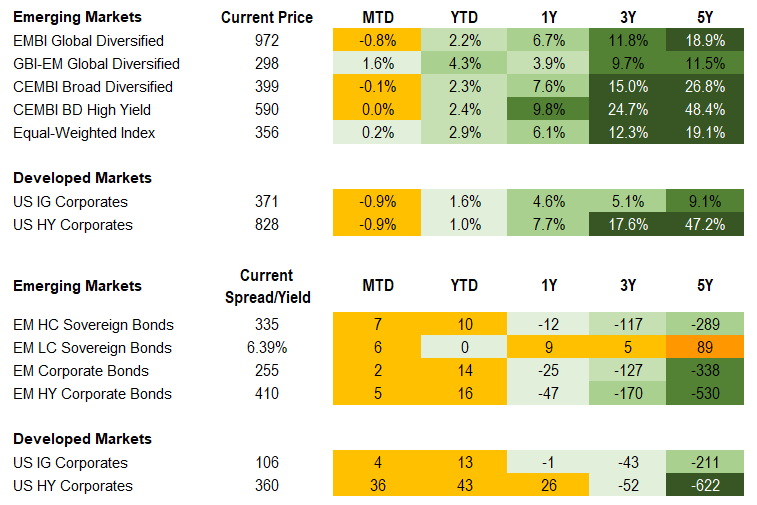
Equities
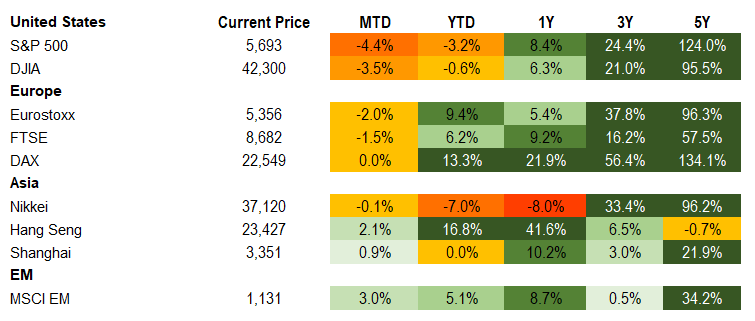
Commodities

Source for data tables: Bloomberg, JPMorgan, Gramercy. EM Fixed Income is represented by the following JPMorgan Indicies: EMBI Global, GBI-EM Global Diversified, CEMBI Broad Diversified and CEMBI Broad High Yield. DM Fixed Income is represented by the JPMorgan JULI Total Return Index and Domestic High Yield Index. Fixed Income, Equity and Commodity data is as of March 28, 2025 (mid-day).
Country Highlights
In Ukraine, Black Sea Ceasefire Does Not Increase Odds of Peace
Event: Following “shuttle diplomacy” talks with Ukrainian and Russian delegations in Saudi Arabia, the White House announced that both sides have agreed to “ensure safe navigation, eliminate the use of force, and prevent the use of commercial vessels for military purposes in the Black Sea.” The parties also appeared to agree to continue negotiations over ceasing attacks on energy infrastructure.
Gramercy Comment: This week’s round of talks and incremental agreements showed that both Ukraine and Russia remain committed to demonstrating engagement in negotiating a “peace deal” with the Trump Administration’s mediation. However, progress toward a sustainable peace deal that satisfies both sides and provides credible, medium-term security guarantees for Ukraine remains as elusive as ever, in our view. Even the Black Sea truce is shrouded in significant uncertainty given that Moscow appeared to condition it on the lifting of Western sanctions on Russian banks and companies involved in agricultural exports. This is an issue that the Trump Administration has not commented on and one that European leaders, including UK Prime Minister Keir Starmer and German Chancellor-in-waiting Friedrich Merz, have already rejected.
Against this backdrop, President Volodymyr Zelenskiy met in Paris with his main European allies to discuss how a “coalition of the willing” can provide continued military and financial assistance for Ukraine amid the potential withdrawal of U.S. support. He also emphasized that with European help, Ukraine “will not surrender” to Russian President Vladimir Putin’s demands. Meanwhile, the deployment of European peacekeepers to Ukraine as part of a potential agreement is a non-starter from Moscow’s perspective. In that context, despite messages of optimism on the outlook for peace by various stakeholders, our assessment remains that the two sides’ conditions for ending the conflict remain too far apart, not leaving space for a sustainable resolution any time soon.
Pakistan Reaches Agreement with IMF on Existing and New Facilities
Event: The IMF staff and the Pakistani authorities reached an agreement on the first review of the 37-month Exchange Funded Facility (EFF) and a new $1.3 billion, 28-month Resilience and Sustainability Facility (RSF). Upon Board approval, the authorities will receive $1 billion under the EFF. The press release emphasized the government’s strong commitment to gradual fiscal consolidation, sufficiently tight monetary policy, rebuilding of FX reserve buffers, and cost reducing energy sector reforms. The RSF financing will help to build resilience against natural disasters, promote climate adaptation, and improve water usage efficiency and productivity. Pakistan’s bond spreads tightened slightly on the week.
Gramercy Comment: The agreements and associated financing are credit positive and in line with our expectations. Relatively swift completion of the process is indicative of authorities’ solid ability to push forward with macroeconomic adjustment under the program. We expect continued reform progress and the completion of additional reviews this year to help anchor spreads and deliver gradual positive rating momentum. Given Pakistan’s historical track record of uncompleted IMF programs amid shifting army alliances, close monitoring of political, military, and social dynamics remains key to assessing execution risks.
Emerging Markets Technicals
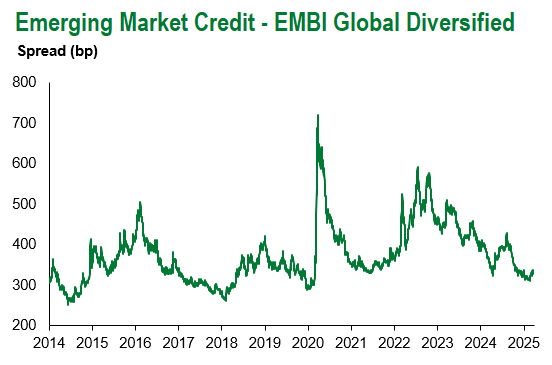
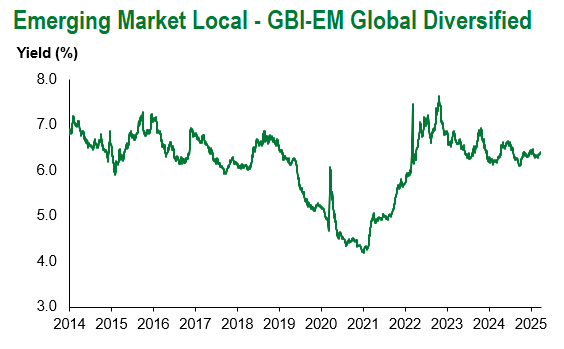
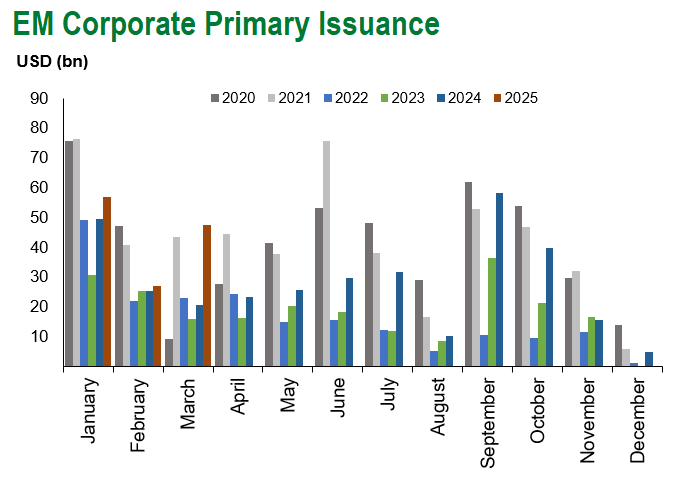
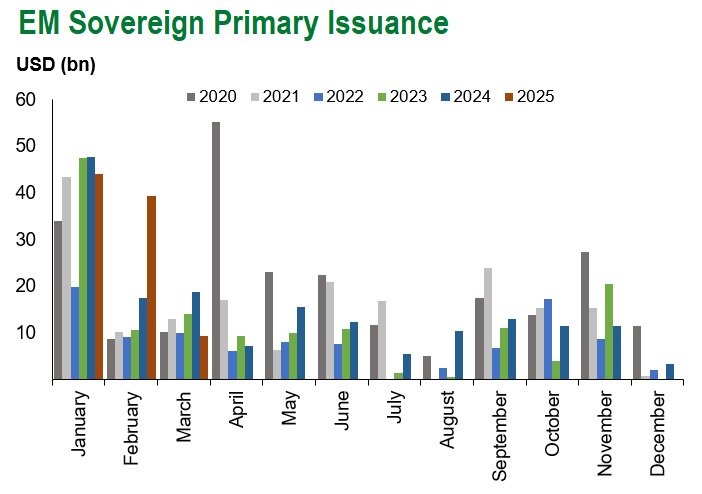
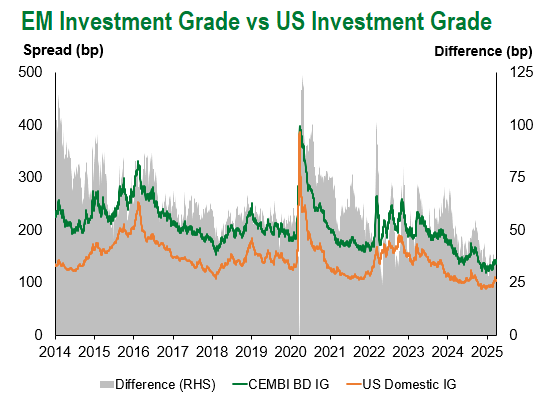
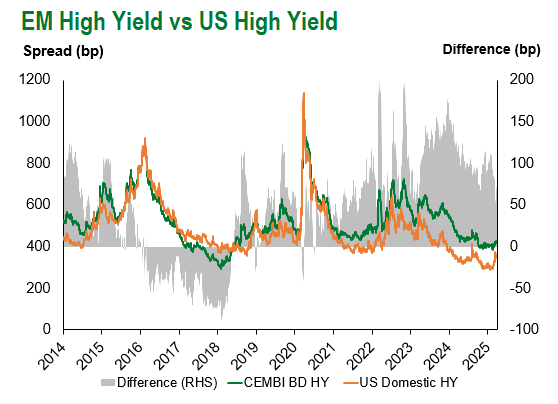
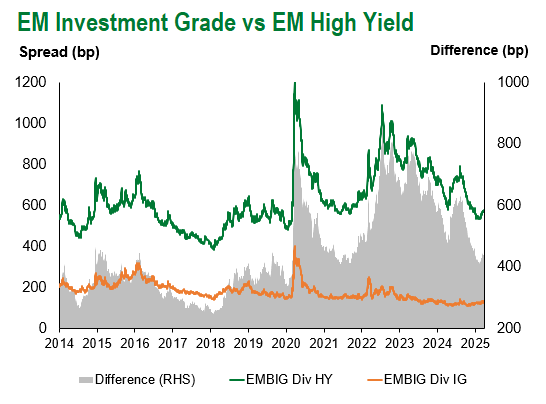
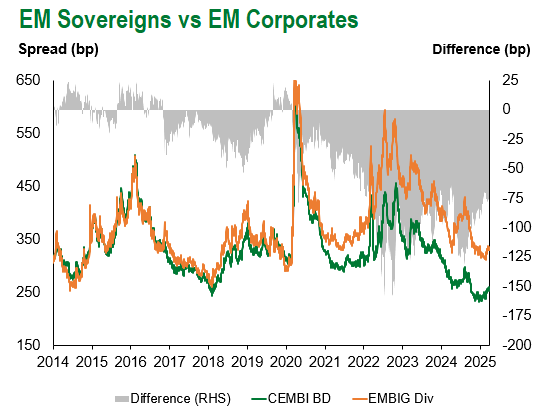
Emerging Markets Flows
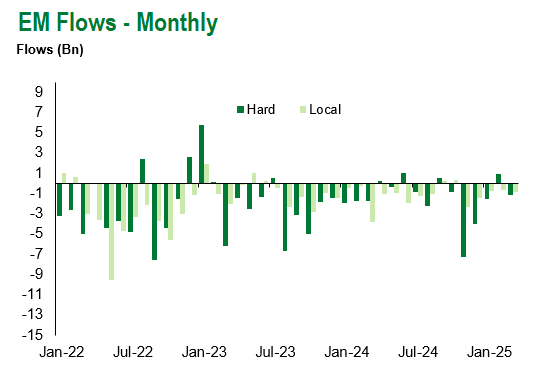
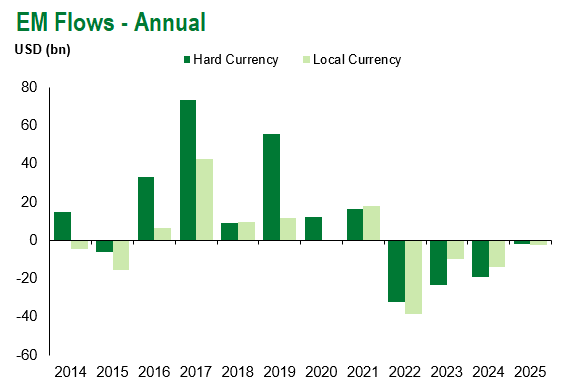
Source for graphs: Bloomberg, JPMorgan, Gramercy. As of March 28, 2025.
For questions, please contact:
Kathryn Exum, CFA ESG, Director, Co-Head of Sovereign Research, [email protected]
Petar Atanasov, Director, Co-Head of Sovereign Research, [email protected]
This document is for informational purposes only. The information presented is not intended to be relied upon as a forecast, research or investment advice, and is not a recommendation, offer or solicitation to buy or sell any securities or to adopt any investment strategy. Gramercy may have current investment positions in the securities or sovereigns mentioned above. The information and opinions contained in this paper are as of the date of initial publication, derived from proprietary and nonproprietary sources deemed by Gramercy to be reliable, are not necessarily all-inclusive and are not guaranteed as to accuracy. This paper may contain “forward-looking” information that is not purely historical in nature. Such information may include, among other things, projections and forecasts. There is no guarantee that any forecasts made will come to pass. Reliance upon information in this paper is at the sole discretion of the reader. You should not rely on this presentation as the basis upon which to make an investment decision. Investment involves risk. There can be no assurance that investment objectives will be achieved. Investors must be prepared to bear the risk of a total loss of their investment. These risks are often heightened for investments in emerging/developing markets or smaller capital markets. International investing involves risks, including risks related to foreign currency, limited liquidity, less government regulation, and the possibility of substantial volatility due to adverse political, economic or other developments. References to any indices are for informational and general comparative purposes only. The performance data of various indices mentioned in this update are updated and released on a periodic basis before finalization. The performance data of various indices presented herein was current as of the date of the presentation. Please refer to data returns of the separate indices if you desire additional or updated information. Indices are unmanaged, and their performance results do not reflect the impact of fees, expenses, or taxes that may be incurred through an investment with Gramercy. Returns for indices assume dividend reinvestment. An investment cannot be made directly in an index. Accordingly, comparing results shown to those of such indices may be of limited use. The information provided herein is neither tax nor legal advice. Investors should speak to their tax professional for specific information regarding their tax situation.
